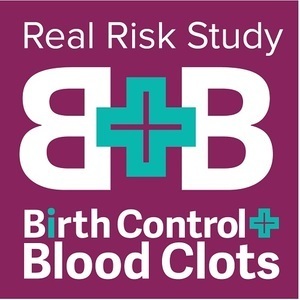A few months ago we began the Real Risk: Birth Control and Blood Clots study. The goal is to determine the real risk of birth control induced blood clots in real women, with real lives, and complicated health histories. The project, like each of our others, relies heavily on patient stories and the patient’s (or patient’s family’s) recollection of health issues preceding the blood clot crisis. This type of self-reporting is messy, complicated, and in many cases, carries with it inherent flaws. For all the difficulties, however, I believe crowdsourced research offers the opportunity for unheralded discoveries, not just because in women’s healthcare medication safety and efficacy evidence is, and has always been, sorely lacking, but also, because I believe in women. I believe in the wisdom of their voices. For too long, women’s voices have been silenced, even where our own bodies are concerned. We aim to change that, one story and study at a time.
Not unexpectedly, however, we have been chided and our efforts blocked by more traditional researchers and patient advocacy groups (especially those sponsored by industry). It is not the kind of research ‘real’ scientists do, we are told. Real research is filtered through the lens of the medical-pharmaceutical establishment. Real research is hierarchical and highly controlled. Real research eliminates as many confounding variables as possible; variables like medication and lifestyle interactions, the very real-life variables we embrace. Most importantly, real research is sanctioned, either by academia or industry. For if it is not, it cannot be real, and it certainly is not valid, no matter the rigor.
What Constitutes Real Research?
One might surprised to find what constitutes real research. Did you know that fewer than 50% of all pharmaceutical treatments have any data supporting efficacy. Of that evidence, much could be suspect given the rampant payments from pharmaceutical and device companies to physicians and other decision-makers, plus the well-documented publishing bias and even fraud plaguing the scientific publishing industry. Real research, conducted by the real scientists and sanctioned appropriately, may be no better than flipping a coin.
In women’s healthcare, matters are even worse. Not only are evidenced-based, clinical practice guidelines nearly non-existent in gynecology (only 30% of practice guidelines based on data), and women still not included in early stage clinical trials in sufficient numbers, but regulatory agencies do not mandate analytics to determine sex-based differences in medication safety or efficacy. The result, post-market adverse events – think death and disabling injury – are more common in women than men. When superimposed upon a deep-seated medical mistrust of women’s symptoms, is it any wonder women’s healthcare is dangerous to women? Again, however, this is the real research that experts speak of so highly.
Women Are Different than Men
Digging a little deeper, it becomes abundantly clear why women’s healthcare is so dangerous for women. Most medications reach the market without having ever done the appropriate testing or analytics to distinguish why women might respond to said medications differently than men. Indeed, prior to 1998, women of childbearing potential were prohibited from participating in clinical trials. So every medication that came to market before these regulations, was not tested on women.
Even in the lab, male rodents are used about 90% of the time, because dealing with the rodent estrus cycle is considered too expensive and too complex. It was only a few years ago that the National Institutes of Health (NIH), the major funding agency for most early stage research, began mandating that female animals be used in all basic research — 2014!!! This was only after a large, media driven, public embarrassment (see Leslie Stahl’s reporting on 60 minutes). It remains to be seen if the differences between male and female animals will be analyzed, or if, like the continuously eroding 1998 regulations, researchers have only to check a box assuring the presence of female animals in the study design.
Medications for Women Only
What about medications developed specifically for women – like hormonal birth control? Certainly, these types of medications included females? While it is true, the development of hormonal birth control used female test subjects, the study was small, hugely flawed and completely unethical – women were forced to stay on the pill despite experiencing serious side-effects, including death by blood clot, but also, by suicide. Almost a fifth of the participants suffered serious side effects, side effects that were discussed in the Nelson Pill Hearings but ultimately dismissed and ignored. And now, decades later, we are only just beginning to revisit those side effects.
For the newer formulations of hormonal contraception, only efficacy is ever tested. Safety is largely ignored. As a result, with each change in formulation and administration route (cervical rings, IUDs, patches, etc.), the side effects appear to increase not decrease. The newer generations of birth control are several-fold more clot-inducing than their predecessors, despite marketing admonitions to the contrary.
I think it is important that hormonal contraceptives prevent pregnancy, but it is equally important that they don’t cause blood clots, stroke, heart attack or cancer. And if blood clots, stroke, heart attack or cancer are deemed acceptable risks for birth control (and I don’t think they are), then shouldn’t we know which forms are the most dangerous and which women are most at risk?
One cannot manage, what one does not measure and we don’t measure critical components of women’s health. We also don’t track adverse events or side-effects very well. Question: have you ever reported a side-effect to a doctor? Do you know if he/she reported it to the FDA, the CDC or any other adverse events registry? Probably not, and that is the problem.
If you knew you had a 20 times higher risk of stroke or heart attack for one medication versus another, would you choose differently? I bet you would, but as medical consumers, we don’t have that information. In many cases, those data don’t exist. We’re collecting those data and we need your help. If you are a woman, please consider taking the birth control and blood clots survey. There are four arms to the survey. It is likely that you fit into one.
Who is Eligible to Participate in the Birth Control and Blood Clots Survey?
- Women who have experienced a blood clot(s) while using hormonal birth control: take survey now
- A family member or partner of a woman who has suffered from deadly or disabling birth control induced blood clots: take survey now
- Women who are currently using hormonal birth control, have used hormonal birth control for at least 1 year, and have not had a blood clot: take survey now
- Women who have never used hormonal birth control or synthetic hormones of any kind: take survey now
Chances are you know someone who has experienced ill-effects, perhaps even blood clots, from hormonal birth control. Please share on social media.












